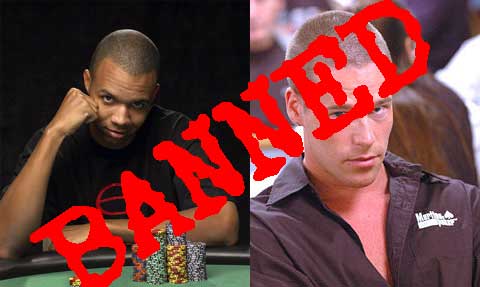
For whatever reason a lot of other poker sites seemed to pick up on the post I wrote about iPoker kicking Blonde Poker off their network for having too many good players. If I remember correctly, Dr. Pauly mentioned it as well as a few other blogs but I was somewhat surprised to see that Gambling911 actually wrote an article about my post.
Then from there they started discussing it on The Hendon Mob boards and I realized that I really should clarify a bit. The Gambling911 article wasn’t a full representation of what I wrote. They basically focused on the part about banning Phil Ivey and Patrik Antonius which was more or less just a way of demonstrating how short-sighted these poker networks are being. I don’t seriously believe that Ivey, Antonius or any other player should be banned for being good.
But the real point to be made here is that there is something fundamentally flawed in the network model. Blonde Poker is a perfect example of what’s wrong. Blonde Poker, as far as I know, was not in the poaching business. By that I mean, I’m unaware of any accusation that they were stealing customers from other skins on the iPoker network. So, basically, they’re a site that attracts better than average players and they monetized that traffic by setting up a skin on iPoker. And because they had too many good players iPoker basically kicked them off the network.
Now, you could go back to the beginning and ask whether or not Blonde should have ever been given a skin in the first place. What kind of marketing budget did they have? What were their plans for player growth? What mix of players were they going to be bringing to the table? Those are all questions every potential skin should be asked and if the network doesn’t like the answers they shouldn’t give them the skin. In my opinion, Blonde probably shouldn’t have ever been given their own skin.
Basically, networks like iPoker and Bodog are trying to artificially shape their player base. They believe that if they penalize sites bringing in too many sharks that there will be less sharks. But the sharks are going to go where the games are juicy. If you stock your pond with juicy fish the sharks will always show up to feast. Notwithstanding some of the people who feel bitterness towards iPoker for the Blonde incident, what’s to stop any of those players from signing up on another iPoker skin and continuing to be winning players? In fact, several Blonde Poker players had been offered under the table rakeback deals from other skins and they turned them down to give their business to Blonde.
One of the problems with the network model is that they operate it like a franchise model without . . . you know . . . all the benefits of being part of a franchise. If you want to be a skin you pay a big upfront fee for them to customize the software and then a fairly substantial cut of the rake collected from your players. But the network doesn’t really invest anything into signing up new players. If you’re a McDonald’s franchisee you expect McDonald’s to buy advertising and to promote the brand. That’s what part of your franchise fees and the cut you’re giving them of the revenue is supposed to be buying. But in the network model none of that gets reinvested in promoting the brand.
So the skin ends up bearing the weight of bringing players through the door. And unless you have deep pockets and/or a well-known brand (*ahem* WSOP) it’s very hard to compete these days. And therein lies the flaw in the business model. Most of the skins don’t have the capital to compete in this market. Demanding better good to bad player ratios isn’t going to change that.
Just a rough count of the number of skins on iPoker (according to Poker Scout) put 68 rooms on their network. And their traffic is only about equal to Party’s (slightly ahead of Party). Based on Party’s published results they do about $300 million a year. So if Party and iPoker are roughly the same size then that means that $300 million a year is being split by 68 poker rooms. That comes out to about $4.4 million a year per room. And that’s just revenue. Figure they see about 30% of that so $1.3 million and some change after costs. That’s a joke in a market where Full Tilt Poker and PokerStars spend more than that every month.
Of course, that’s assuming that revenues are evenly distributed over the entire network. Realistically, the 80/20 rule probably applies meaning that 20% of the skins are generating 80% of the revenue. The other 80% are barely going to be turning a profit. How are they supposed to fund the type of marketing that will bring in new players? They can’t.
If the 80/20 rule is accurate then that means of the $300 million in revenue the lower 80% are generating only $60 million. So 54 rooms (80% of 68 rooms) generating only $60 million in revenue is under $1 million a year gross. After costs they’re pocketing less than $300,000 per room.
I think this is what some of the networks are beginning to realize. The smaller skins on their network have contracted down to a hand full of sharks who generate the room’s monthly nut. The rooms making the big money (those in the 20% bringing in 80% of the revenues) are getting angry that the money they’re investing in bringing in new players gets sucked out of the system by those other rooms but the smaller rooms have no other option. They don’t make enough money to be able to run effective marketing campaigns and they don’t have sports book customers to cross-sell. I’m sure they would love to be sending huge fish into the pond but they don’t have the resources to do it.
It’s like being stuck between a rock and a hard place because there is no popular solution to the problem. Either you need to cut the smaller rooms off and take the liquidity (and revenue) hit or you need to tell the sports books to suck it up. Neither of which is going to make you any friends.

1 thought on “Ban Phil Ivey and Patrik Antonius from Online Poker? REVISITED”
Comments are closed.